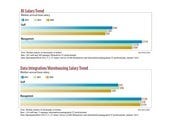Watch out Salesforce.com: SAP releases a Hana in-memory database upgrade capable of running core transactional applications, starting with a customer relationship package.


Big Data Talent War: 7 Ways To Win
Big Data Talent War: 7 Ways To Win (click image for larger view and for slideshow)
For years now, SAP has said its Hana in-memory database would eventually support both analytic uses and core transactional applications. That day has finally arrived.
SAP on Tuesday reached the first major milestone in running applications in memory with the release of an update of Hana together with a preview release of the SAP 360 Customer solution, a package clearly aimed at competing with Salesforce.com. Under the hood is SAP CRM, an updated core, on-premises application tuned to run on Hana.
SAP's announcement was made at SAP's Sapphire Now event in Madrid, where the vendor also announced the anticipated release of SAP Financials OnDemand. But the center of attention was Hana. SAP has long promised that running both transactional and analytical workloads on a single database would drive "dramatic simplification" by eliminating layers of complexity and data redundancy built into conventional architectures.
With applications like CRM and analytics like data marts, warehouses and analytic apps running on a single database, SAP says Hana will consolidate the database layer. That's the vision, but with just one major core app now supported (with CRM now moving into beta on Hana), customers will still need a separate database(s) for all their other transactional applications.
[ Want more on SAP's evolved cloud computing strategy? Read SAP's Ugly (ByDesign) Baby Gets Prettier. ]
On the database side, SAP released Hana Service Pack Stack 5 (SPS5), which the company described as a simple, plug-in-style update of Hana -- not an "upgrade" or "replacement" that will require an IT-intensive deployment. Nonetheless, the update packs new features including Extended Application Services that will enable customers to deploy HTML5, Javascript, SQL Script, JSON and ODATA applications directly on Hana, without a Web application server that other vendors (like Oracle) would require.
SPS5 also beefs up Hana's analytics capabilities with built-in natural-language-based text analytics (for uses such as sentiment analysis in 31 languages) and a broader set of embedded predictive algorithms than previously available. Hana also now supports PMML (predictive Model Markup Language), so a range of third-party models can now be integrated with Hana.
The vendor says running SAP CRM on Hana reduces the size of CRM databases by 50% because Hana does not require indexes. More than 10 early adopter customers including Lenovo are now running CRM on Hana, according to SAP, and the company is now recruiting customers to join its "ramp-up" beta-testing program. The general release of SAP CRM on Hana would follow within three to six months. Of course, those migrating existing CRM deployments to Hana will also have or acquire the memory-intensive hardware necessary to run the application entirely in memory.
The broader SAP 360 Customer solution that the company introduced on Tuesday goes beyond CRM, addressing not just sales force automation and customer service but also marketing and customer-facing mobile applications.
"It's an entirely new and extended packaging of SAP CRM, and we're going from being a back-end CRM company to enabling front-line employees and consumer experiences," said Amit Sinha, VP of SAP Hana solution marketing.
That billing sounds like it could have been written by Salesforce.com's marketing department, as it emphasizes the front-office worker ties and relationships with marketers that SAP's biggest cloud rival has cultivated through its acquisitions of Radian6 and Buddy Media .
The substance backing up SAP's marketing claim is a long list of bundled applications, including Social Media Analysis (a Hana-based application), Sales OnDemand (a cloud-based sales force automation app), SAP Audience Discover and Targeting (an on-premises app that segments customers using CRM data), and SAP Account Intelligence (an on-premises that analyzes customer-purchase histories using CRM data).

Big Data Talent War: 10 Analytics Job Trends
Big Data Talent War: 10 Analytics Job Trends (click image for larger view and for slideshow)
SAP is also throwing its Jam collaboration platform and a few customizable, consumer-facing mobile applications into the mix (one for shopping, one for the fashion industry and one for product recalls), but does it all hang together as a coherent customer-experience platform? Time will tell as it has yet to be beta tested, let alone released.
SAP says what unites and differentiates SAP 360 Customer is the performance of Hana, which will power real-time transactions and interactions as well as provide insights into customer needs, preferences and behavior (through the Discover and Targeting, and Account Intelligence apps). In a customer loyalty interaction, for example, many companies update loyalty points once a month because it's a slow, back-end processing application.
"We've changed that and made it real time, so the customer is on a Hana-powered retail app, the points are on their phone the instant they buy and they're also connected to the store inventory available at that moment," Sinha explains. "I don't think Salesforce.com has anything close to this power, and I don't think they will get there within the next five years."
[ Want more on SAP's evolved cloud computing strategy? Read SAP's Ugly (ByDesign) Baby Gets Prettier. ]
With the release of SAP Financials OnDemand the vendor is delivering accounting, general ledger, financial accounting and management, and project management in a separate, cloud-based package. The service is based on functionality already in use in the vendor's cloud-based SAP Business ByDesign suite. But unlike ByDesign, which is intended to be all-inclusive, Financials OnDemand is described as open and extensible, with options to "plug in" myriad third-party applications and financial data sources.
"Customers can plug in Sales OnDemand, Employee Central, and Payroll from us, or they can use third-party apps because all of the financial processes we've designed have open plug-ins," Chris Horak, Global VP of product marketing for SAP's cloud business unit, told InformationWeek.
Financials OnDemand also runs on Hana, and the in-memory database is once again said to be a differentiator. "We're not just talking about [historical] analytics, we're getting real-time income statements, profitability statements, business-unit analyses and general ledgers out to everybody with costs allocated so you can really see what's going on in your business," said Horak.
SAP envisions two types of customers for the cloud-based service. Midmarket firms will choose it as a replacement for aging and fragmented on-premises financial management components from disparate accounting and ERP applications. Larger enterprises are unlikely to replace core ERP financials components they've invested in, but SAP says the will use Financials OnDemand to consolidate fragmented systems in use across many smaller units. They might also use the service where mergers and acquisitions require better tools for financial management.
Competitors to the service include Workday and NetSuite. Workday combines human capital management and financials in the cloud, a combination SAP can now deliver with the combination of Financials OnDemand and SuccessFactors. NetSuite has a complete applications suite in the cloud akin to SAP's Business ByDesign, but it has customers who focus on its financial management applications. Salesforce.com has AppExchange partners including FinancialForce.com, of which it is a minority owner, as well as Accounting Seed and other vendors that have apps integrated with Force.coms.
SAP plans to add performance management functionality to Finance OnDemand, said Horak, a move that would cut into cloud applications from the likes of Adaptive Planning, Host Analytics, Tidemark and Anaplan.
About the Author(s)
You May Also Like







